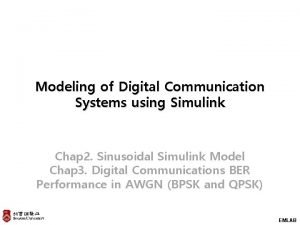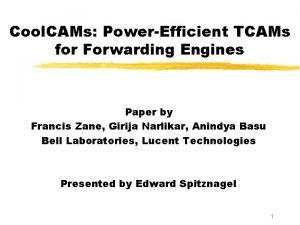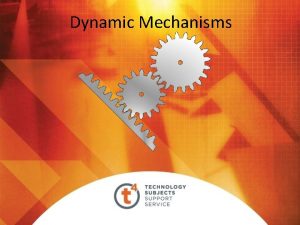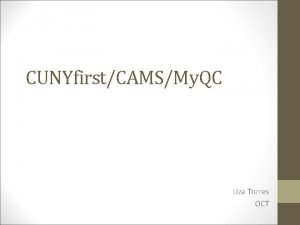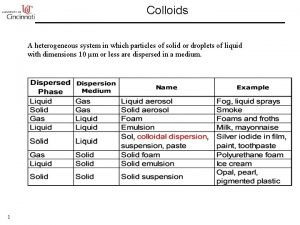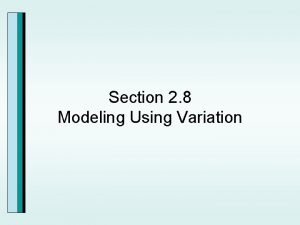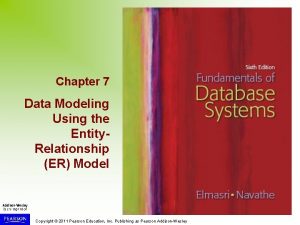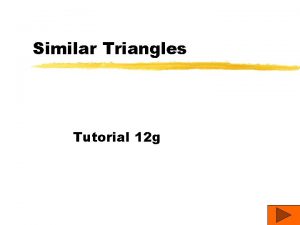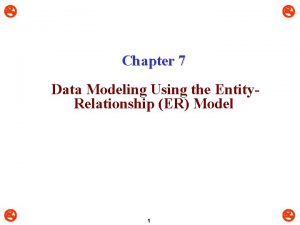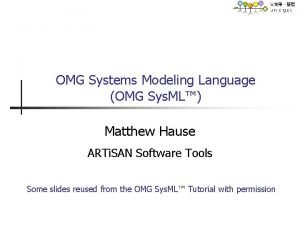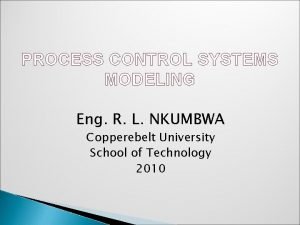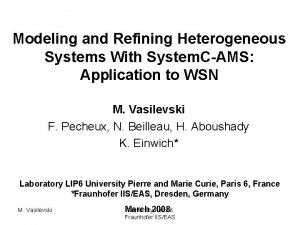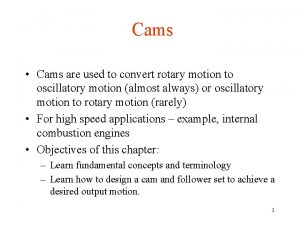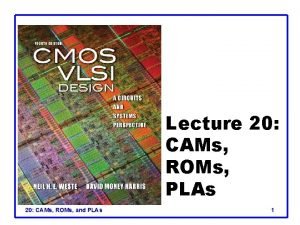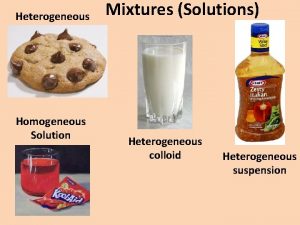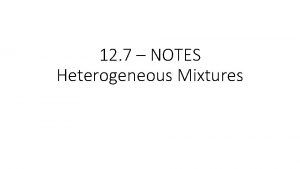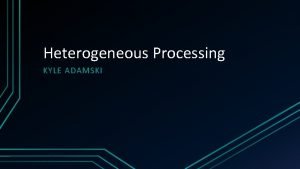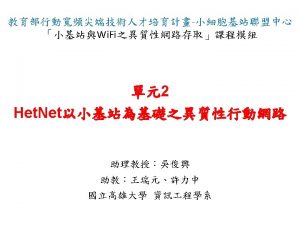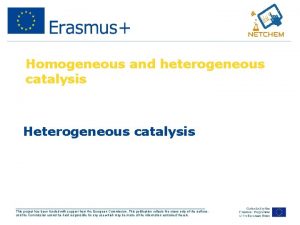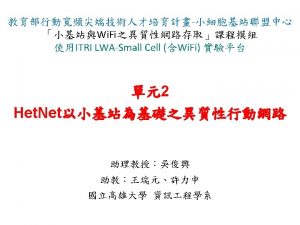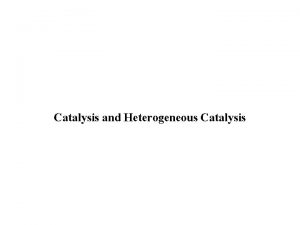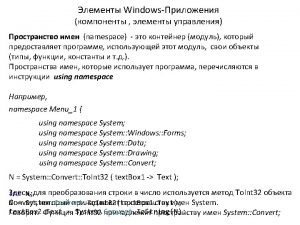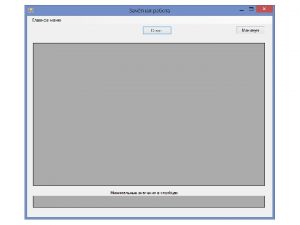Modeling Heterogeneous Systems Using System CAMS A Case























- Slides: 23

Modeling Heterogeneous Systems Using System. C-AMS, A Case Study: A Wireless Sensor Network Node {Michel. Vasilevski, François. Pecheux, Hassan. Aboushady, Laurent. Delamarre}@lip 6. fr Laboratoire d’Informatique de Paris 6, 4, place Jussieu 75252 PARIS Cedex 05

Presentation overview n n System. C-AMS, Models of Computation System. C-AMS description of the WSN Results Ongoing research

System. C-AMS n n Introduced by Christoph Grimm (TU Vienna), Alain Vachoux (EPFL), Karsten Einwich (Fraunhofer Institute Gesellschaft, Dresden) First prototype released by Karsten Einwich, available at www. systemc-ams. org, release candidate RC 2 OSCI AMS Working Group, managed by Martin Barnasconi (NXP). Lots of companies and academic partners Currently writing the LRM

2 Models of Computation implemented n n Conservative Mo. C n Dedicated to linear electrical networks, Kirchoff current law n If we limit application field to linear dynamic and non linear static, fast equation solver can be used Non-conservative Mo. C, Multi-rate Synchronous Dataflow

SDF Cluster Module SDF output port Module SDF input port SYSTEMC-AMS CLUSTER A B out in C

Module behavior: sig_proc() function sca_sdf_in<double> input; sca_sdf_out<double> output; void sig_proc() {. . . output. write( Behavior. Function(input. read(), …)) … }

Single rate dataflow n n n Modules static scheduling computed during system elaboration A, B, and C are scheduled in that order when cluster is triggered Cluster sample period set with set_T(), propagated to all modules out. set_T(sc_time t) CLUSTER A 1 out 1 B 1 1 C

Handling multirate dataflow n set_rate() can be used on module ports to modify input (consuming) and output (producing) rates according to equation: out. set_T(ta) in. set_rate(5) 5 calls to sig_proc() A A 1 1 call to sig_proc() B 5 B 1 1 in ta 1 call to sig_proc() C tb C

Decimator, interpolator Decimator A 1 5 B 1 1 C in tb ta Interpolator A 1 1 B 5 in in. read(i) out. write(val, j) ta tb

The modeled WSN

The sensor #ifndef WAVE_H #define WAVE_H SC_MODULE (wave) { sca_elec_port w 1; sca_elec_ref gnd; sca_isin sca_r *i_sin_1; *i_r_1; void init(double a, double f){ i_r_1 ->value = a*1000; i_sin_1 ->freq = f; } SC_MODULE (interface_v 2 sdf) { sca_elec_port in; sca_sdf_out<double> out; sca_v 2 sdf *i_v 2 sdf_1; SC_CTOR (interface_v 2 sdf) { i_v 2 sdf_1 = new sca_v 2 sdf("i_v 2 sdf_1"); i_v 2 sdf_1 ->p(in); // pos i_v 2 sdf_1 ->sdf_voltage(out); // i_v 2 sdf_1 ->scale=1. 0; // scaling factor } }; SC_CTOR (wave) { i_sin_1=new sca_isin("i_sin_1"); i_sin_1 ->p(w 1); // pos i_sin_1 ->n(gnd); // neg i_sin_1 ->ampl=0. 001; // magnitude in A i_r_1=new sca_r("r 1"); i_r_1 ->p(w 1); i_r_1 ->n(gnd); } }; #endif

2 nd order Sigma-Delta converter

2 nd order Sigma-Delta Integrator #ifndef INTEGRATOR_SD_H #define INTEGRATOR_SD_H SCA_SDF_MODULE (integrator_sd) { sca_sdf_in < double >in 1; sca_sdf_in < double >in 2; sca_sdf_out < double >out; double fs, ai, ki; sca_vector < double >NUM, DEN, S; sca_ltf_nd ltf 1; void init DEN (0) DEN (1) NUM (0) ai=a; fs=f; ki=k; } (double a, double f, double k) { = 0. 0; = 1. 0/3. 0; void sig_proc () { out. write (ltf 1(NUM, DEN, S, fs * (ai * in 1. read () - ki * in 2. read ()))); } SCA_CTOR (integrator_sd) {} }; #endif

2 nd order Sigma-Delta « System. C-AMS » decimator #ifndef SAMPLER_SD_H #define SAMPLER_SD_H SCA_SDF_MODULE (sampler_sd) { sca_sdf_in < double >in; sca_sdf_out < double >out; double input; void init (int r) { in. set_rate(r); } void sig_proc () { out. write(in. read(0)); } SCA_CTOR (sampler_sd) {} }; #endif System. C-AMS Decimator 85. 3 MHz to 8. 53 MHz

ATMEL Atmega 128 BCA Instruction Set Simulator main: ldi R 16, 0 x 01 out DDRA, R 16 ; port. A 0 output ldi R 16, 0 x 00 out DDRB, R 16 ; port. B[7: 0] input loop: in R 16, PINB ; read ADC out PORTA, R 16 ; shift Bit 0 lsr r 16 out PORTA, R 16 ; shift Bit 1 lsr r 16 out PORTA, R 16 ; . . . lsr r 16 out PORTA, R 16 lsr r 16 out PORTA, R 16 rjmp loop ; and loop HEX File : 10000 C 9446000 C 9463000 C 94630001 : 10000 C 9463000 C 946300 D 4 : 100020000 C 9463000 C 946300 C 4 : 100030000 C 9463000 C 946300 B 4 : 100040000 C 9463000 C 946300 A 4 : 100050000 C 9463000 C 94630094 : 100060000 C 9463000 C 94630084 : 100070000 C 9463000 C 94630074 : 100080000 C 9463000 C 94630011241 FBE 55 : 10009000 CFEFD 0 E 1 DEBFCDBF 11 E 0 A 0 E 0 B 1 E 0 ECEEEC : 1000 A 000 F 0 E 00 BBF 02 C 007900 D 92 A 030 B 10756 : 1000 B 000 D 9 F 711 E 0 A 0 E 0 B 1 E 001 C 01 D 92 A 030 B 10776 : 1000 C 000 E 1 F 70 C 9465000 C 940000 CFEFD 0 E 1 DEBFA 7 : 1000 D 000 CDBF 8 FEF 80933 A 00109237008 FEF 80935 F : 0 C 00 E 0003 B 008091360080933 B 00 F 8 CF 7 D : 00000001 FF

RF Transceiver: Transmitter

SCA_SDF_MODULE (mixer) { sca_sdf_in < double >in; sca_sdf_out < double >out; RF Transceiver: Transmitter double ampl; bool func; double wc; double Ts; double dc_offset; double phase_mismatch; double gain_mismatch; double pulsation_offset; … void sig_proc () { double t = in. get_time(). to_seconds()+Ts; // get_time() returns previous time switch(func){ case COS: out. write((in. read()*cos((wc+pulsation_offset)*t+ phase_mismatch/2)*ampl+dc_offset)*(1+(gain_mismatch/2))); break; case SIN: out. write((in. read()*sin((wc+pulsation_offset)*tphase_mismatch/2)*ampl+dc_offset)*(1 -(gain_mismatch/2))); break; } } void init(bool f, sc_time tc, sc_time tb, sc_time ts, double dc_o, double g_m, double ph_m, double f_o){ … } SCA_CTOR (mixer) {} };

RF Transceiver: Receiver

Simulation results

Accuracy System. C-AMS vs Matlab

Bit Error Rate (BER)

Taking non-idealities into account

Ongoing research n n Non-linearities, LNA, Noise, CP 1, IIP 3 Baseband-equivalent
 Modeling of digital communication systems using simulink
Modeling of digital communication systems using simulink Modeling of digital communication systems using simulink
Modeling of digital communication systems using simulink Benchmark cams
Benchmark cams Funky-cams
Funky-cams Cams a
Cams a Cams suicide assessment
Cams suicide assessment Mate cam
Mate cam How to use hellosign
How to use hellosign Cams cuny
Cams cuny Erickson nursing theory
Erickson nursing theory Relational modeling vs dimensional modeling
Relational modeling vs dimensional modeling System collections generic
System collections generic Suspension vs solution
Suspension vs solution Best worst and average case
Best worst and average case Colloid is a heterogeneous system
Colloid is a heterogeneous system Modeling using variation
Modeling using variation Data modeling using entity relationship model
Data modeling using entity relationship model Lesson 12 modeling using similarity
Lesson 12 modeling using similarity Er model diagram
Er model diagram Omg systems modeling language
Omg systems modeling language Rotational mechanical system example
Rotational mechanical system example Control systems modeling
Control systems modeling Manufacturing systems modeling and analysis
Manufacturing systems modeling and analysis Point of sale use case diagram
Point of sale use case diagram
